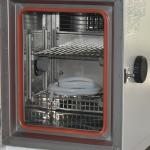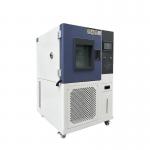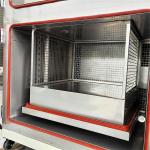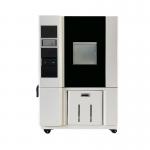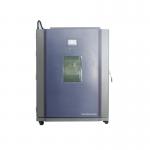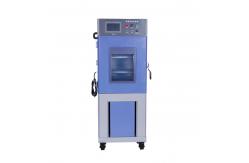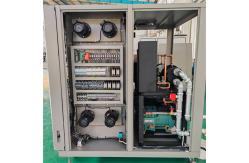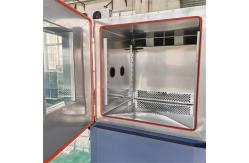In the food industry, maintaining the integrity of food products is
of utmost importance. The Constant Temperature And Humidity
Environmental Simulation Chambers 80L are specifically designed to
meet the unique testing needs of this sector, ensuring that food
items can withstand various environmental conditions and retain
their quality and safety. This 80-liter chamber is engineered to create and maintain precise
and stable temperature and humidity levels. It serves as a vital
tool for food manufacturers, research institutions, and quality
control laboratories. The primary purpose is to conduct tests that
mimic different storage, transportation, and handling scenarios
that food may encounter. By subjecting food samples to these
controlled environments, stakeholders in the food industry can
assess the shelf life, quality, and safety of their products, make
informed decisions about packaging and storage requirements, and
comply with regulatory standards. - Hygienic and Durable Construction
- The chamber is constructed with materials that prioritize hygiene
and durability. The interior is made of food-grade stainless steel,
which is non-reactive, easy to clean, and resistant to corrosion.
This ensures that there is no contamination of the food samples
during testing. The exterior is also built to withstand the rigors
of a food industry setting, typically using high-strength steel or
durable polymers. The insulation is of high quality, minimizing
heat and moisture transfer and allowing for accurate temperature
and humidity control. The door of the chamber is designed for a
tight seal, with a reliable locking mechanism and a gasket that can
endure the pressure differentials caused by temperature and
humidity changes. It features a large viewing window, usually made
of tempered glass with anti-fog and anti-scratch properties,
enabling easy visual inspection of the food samples without
disturbing the internal environment.
- Precision Temperature and Humidity Control Systems
- Temperature Control: The temperature control system is highly
accurate and can maintain a temperature range suitable for food
testing, typically from -20°C to +40°C, with an accuracy of ±0.2°C.
It utilizes advanced refrigeration and heating technologies, along
with a sophisticated feedback loop and multiple temperature sensors
strategically placed throughout the chamber. This ensures uniform
temperature distribution, which is crucial for testing food
products that may be sensitive to temperature gradients. The system
also has built-in safety features to prevent overheating or
overcooling, protecting both the food samples and the chamber
itself.
- Humidity Control: The humidity control system is equally precise,
capable of adjusting the relative humidity from 30% to 90% RH, with
an accuracy of ±2% RH. The chamber is equipped with a
high-efficiency humidifier and dehumidifier, which work in harmony
to achieve rapid and accurate humidity adjustments. Special care is
taken to prevent condensation, as it can lead to mold growth or
spoilage of food samples. The system also features a dew point
control function, which is essential for maintaining the correct
moisture balance in the chamber.
- Programmability: The chamber's control panel is highly
programmable, allowing users to create and store complex
temperature and humidity profiles. This enables the simulation of a
wide variety of storage and transportation scenarios. For example,
it can mimic the temperature and humidity changes during a
long-distance shipment or the seasonal variations in a warehouse
environment. The control panel is user-friendly and intuitive, with
a clear display that shows the current temperature, humidity, and
the status of the testing program.
- Advanced Instrumentation and Data Acquisition
- The chamber is outfitted with a comprehensive suite of sensors.
Temperature sensors are distributed evenly to detect any
temperature gradients and ensure a homogeneous thermal environment.
Humidity sensors provide real-time data on the relative humidity
levels. These sensors are connected to a state-of-the-art data
acquisition system that records and stores all the measured data.
The data can be accessed and analyzed in real-time or retrieved
later for in-depth studies. The data acquisition system is highly
flexible and can be integrated with external software and
databases, facilitating seamless data transfer and analysis. It can
also be configured to send notifications and reports automatically,
saving time and effort for the users. Additionally, the control
panel includes built-in alarms and safety features that alert users
in case of any abnormal conditions, such as temperature or humidity
excursions outside the set limits, power failures, or equipment
malfunctions.
| Model | JTT-80 | JTC-150 | JTC-225 | JTC-408 | JTC-800 | JTC-1000 | | Inside dimension(W x D x H) mm | 40 x 50 x40 | 50 x 60 x 50 | 50 x 75 x 60 | 60 x 85 x 80 | 100 x 100 x 80 | 100 x 100 x 100 | | Outside dimension(W x D x H) mm | 95 x 140 x 95 | 105 x 150 x 105 | 105 x 165 x 115 | 115 x 175 x 140 | 155 x 190 x 140 | 155 x 190 x 160 | | Internal material | #304 Stainless Steel | | External material | Powder coated #304 Stainless Steel | | Temperature range | + 150℃~ - 70 ℃ | | Temperature resolution ℃ | 0.01 | | Temperature stability ℃ | ±0.3 | | Temperature change rate | | | High temperature ℃ | 100 | 100 | 100 | 100 | 100 | 100 | | Heating time (min) | 20 | 30 | 30 | 30 | 30 | 30 | | Low temperature | 0, -40, -70 | 0, -40, -70 | 0, -40, -70 | 0, -40, -70 | 0, -40, -70 | 0, -40, -70 | | Cooling time (min) | 20, 50, 70 | 20, 50, 70 | 20, 50, 70 | 20, 50, 70 | 20, 50, 70 | 20, 50, 70 | | Air circulation system | Mechanical convection system | | Cooling system | Imported compressor, fin evaporator, gas condenser | | Heating system | Sus304 Stainless steel High-speed heater | | Controller | Touch panel | | Electrical power requirements | Please contact us for requirements of specific models | | Safety device | Circuit system load protection, compressor load protection, control
system load protection, humidifier load protection, overtemperature
load protection, fault warning light |
- Accurate Simulation of Food Storage Environments
- The primary function of this chamber is to provide a highly
accurate and realistic simulation of the temperature and humidity
conditions that food may face during storage, transportation, and
handling. By precisely controlling these parameters, it allows food
manufacturers and researchers to evaluate how different food
products will behave in various real-world situations. For example,
it can be used to test the effect of high humidity on the texture
of bakery products or the impact of temperature fluctuations on the
freshness of dairy products.
- The ability to create complex environmental profiles, such as
cyclic temperature and humidity changes, is also a valuable
function. This can help in understanding how food products will
respond to the changing conditions they may encounter during their
journey from the production facility to the consumer's table. For
instance, a food product that is shipped across different climates
may experience temperature and humidity swings, and this chamber
can accurately replicate such scenarios to determine the product's
durability and quality retention.
- Enhanced Food Quality and Shelf Life Determination
- Through comprehensive testing in the chamber, food manufacturers
can identify and address potential issues that could affect the
quality and shelf life of their products. If a food product shows
signs of spoilage or quality degradation under specific temperature
and humidity conditions, the company can make adjustments to the
packaging, storage requirements, or product formulation. For
example, if a meat product deteriorates quickly in a certain
humidity environment, the packaging can be modified to include a
moisture-absorbing liner or the storage temperature can be
adjusted. This leads to the development of more stable and
high-quality food products, reducing waste and increasing customer
satisfaction.
- The test chamber also serves as a valuable tool for research and
development in the food industry. It allows scientists and
engineers to study the effects of temperature and humidity on new
food formulations, ingredients, and packaging materials. For
example, it can be used to evaluate the performance of a new type
of food preservative under different environmental conditions or to
determine the optimal packaging for a perishable food item.
- Compliance with Food Industry Standards and Regulations
- The food industry is highly regulated, and there are strict
standards regarding the storage and transportation conditions of
food products. The Constant Temperature And Humidity Environmental
Simulation Chambers 80L are a reliable tool for ensuring
compliance. For example, certain food products may have specific
temperature and humidity requirements mandated by regulatory
agencies to ensure their safety and quality. By using this chamber
to conduct tests in accordance with relevant standards and
regulations, food manufacturers can prove that their products meet
the necessary criteria, facilitating market access and enhancing
consumer confidence.
|
